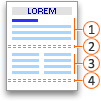Insert, delete, or change a section break
Sections let you set specific page layout and formatting options (such as line numbering, columns, or headers and footers) for different parts of a document. By using sections, for example, you can format the introduction of a report as a single column, and then format the body of the report as two columns. Word treats a document as a single section until you insert a section break.
Tip: To display section breaks and other nonprinting characters, on the Standard toolbar, click Show all nonprinting characters  .
.

 Section formatted as a single column
Section formatted as a single column
 Section break that controls the layout and formatting of the preceding section identified by 1
Section break that controls the layout and formatting of the preceding section identified by 1
 Section formatted as two columns
Section formatted as two columns
 Section break that controls the layout and formatting of the preceding section identified by 3
Section break that controls the layout and formatting of the preceding section identified by 3
Each section break controls the layout and formatting of the section previous to the break. For example, if you delete a section break, the text previous to the break acquires all the formatting of the section that follows the break. For example, in the illustration that was mentioned earlier, if you delete the first section break (2), the first section is formatted as two columns. The last paragraph mark (¶) in the document controls the section layout and formatting of the last section in the document. If the document does not contain sections, the last paragraph mark controls the layout and formatting of the entire document.
Important: The following procedures assume that you are in print layout view. If you are not in print layout view, on the View menu, click Print Layout.
Do any of the following:
Insert a section break
-
In the document, click where you want to insert a section break.
-
On the Layout tab, under Page Setup, click Break, and then click the kind of section break that you want.

The following table shows examples of the types of section breaks that you can insert. In each illustration, the double-dotted line represents a section break.
| Section break type | Description |
| Next page | Inserts a section break and starts the new section on the next page. |
| Continuous | Inserts a section break and starts the new section on the same page. |
| Even page | Inserts a section break and starts the new section on the next even-numbered page. |
| Odd page | Inserts a section break and starts the new section on the next odd-numbered page. |
Delete a section break
-
Click before the section break that you want to delete.
If you don't see the section break, on the Standard toolbar, click
 .
. -
Press
 .
. If your keyboard does not have a
 key, hold down SHIFT and press the right arrow key
key, hold down SHIFT and press the right arrow key  , and then press DELETE .
, and then press DELETE .Note: When you delete a section break, you also delete the section formatting for the text in the section before the break. That text becomes part of the following section, and takes on all section formatting, including margins.
Change the kind of section break
-
Click in the section that you want to change.
-
On the Format menu, click Document, and then click the Layout tab.
-
On the Section start pop-up menu, click the kind of section break that you want.




No comments:
Post a Comment